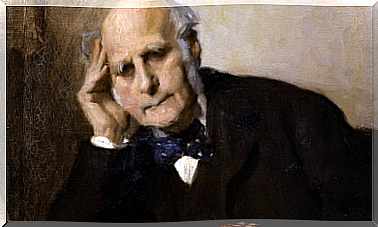Theory Of The Relational Framework

The relational frame theory is a theory about language and cognition that serves as the experimental basis for acceptance and commitment therapy (ACT). From the perspective of relational frame theory, behavior and language are intrinsically related.
It is a theory that aims to study the so-called “mental processes” in an operational and experimental way.
Relational Frame Theory: Concepts and Properties
To understand what a relational framework is, it is necessary to know that human beings do not only learn from direct experiences. People also learn indirectly by relating stimuli beyond their physical properties. This added linguistic value of the stimuli is what would condition their ability to govern relationships and functions.

Properties of a relational framework
To link and transform both cognition and language, there are three properties:
- Mutual bonding. A relationship between two stimuli involves responding to one in terms of the other and vice versa.
If in a given context A is directly related to B, then a derived relationship exists between B and A. - Combinatorial bonding. One of the defining characteristics of relational frames concerns the ability to combine events with each other. If A is related in a characteristic way to B, and A is related to C, B and C would also be related.
- Transformation of functions. Given a stimulus that has a function, if another stimulus establishes a relationship with it in that context, the function of both is transformed by the relationship. For example, if someone tells us that there is a better and cheaper product than the one we usually use, the probability that we will buy it increases. Its role has been transformed by the relationship that has been established.
Type of contextual keys in relational frame theory
Mutual linkages, multiple linkage combinations, and function transformations are components of a broader relational response pattern that relational frame theory (RFT) calls “relational frame. ” The concept is used to explain how we learn to make associations derived from relationships between stimuli.
Relational frames can be combined to generate verbal rules that govern behaviors. This process allows people to organize, predict and control the obtaining of consequences in relation to the context. In this way, future situations can be anticipated without having lived them.
Contextual keys in relational frame theory
Each learning context presents multiple stimuli with the potential to acquire the value of keys that govern the development of relational frameworks. The RFT distinguishes two subtypes of contextual keys:
- Those that govern the type of relationship specified (C rel ). The most notable types are coordination, opposition, distinction, comparison, spatial, temporal, causal, hierarchical, and deictic.
- Because each stimulus or event can have multiple psychological functions, a second class of contextual keys (C func ) will specify which stimulus functions will be transformed (Torneke, 2010).
The theory of the fabric framework as an explanation of human suffering
In this theoretical framework, it could be said that there are some properties of language that make psychological suffering very common. One of them would be, precisely, the ability to literally believe what our thoughts, emotions, sensations mark us and act according to their dictates.
Thus, if a person thinks of himself that he is “garbage” and that “he is worth nothing”, this probably limits his attitude enormously. In this way, we would see how many people give up affordable goals because they think they are out of their reach.
Types of Verbal Rules in Relational Frame Theory
The relational frame theory has delved into this fact, explaining the main types of verbal regulation (Luciano and Wilson, 2002):
- Pliance. In this type of rules, the consequences are achieved by complying with them and the consequences are applied by the person who generated the rule. They are behaviors that are largely determined by what the cultural context determines as appropriate. For example, a mother says “If you don’t eat, I will punish you.”
- Tracking. They are verbally regulated behaviors that guide the human being to obtain concrete reinforcers in the context, they are directly associated with the consequences obtained from the behavior. For example, “If you eat, you will stop being hungry and you will feel better.” In this case, the consequences would depend on the characteristics of the food and it is independent of who has stated the rule.
- Augmenting. It is a transformation of functions that determines that a verbal stimulus, object or event acquires a reinforcing or aversive value. It is important to note that they always operate in combination with pliances and trackings.
The augmenting verbal rule that changes the reinforcing properties of a stimulus that functions as a result, that is, increases or decreases the probability that this stimulus as a result influence on behavior.
For example, passing by an ice cream shop, someone says: “How good an ice cream would do us now!” When we hear or read this phrase, we feel to some extent the taste and freshness of the ice cream, which increases the probability of consuming it.
Behavior patterns determined by verbal rules
Verbal regulations allow us to govern our behaviors based on the context, but they can also have different adverse effects :
- A rigid follow-up of Pliance rules makes the individual insensitive to the consequences present in the environment. An example would be: “You have to suffer a lot to be a good mother .” Its rigidity would limit the assertive repertoire necessary to defend basic rights.
- The Trackings rules determine behaviors aimed at obtaining short-term benefits but which limit the development of important behaviors for personal development: “I must use drugs to calm myself down.”
- The Augmentals operate in coordination with the rigid rule – following or counterproductive. They can specify aversive functions for private events “You cannot live with worries” or appetitive functions for constant and unattainable emotional conditions “Living happy is healthy.”

Contributions and advantages of the relational frame theory
The relational frame theory has led to the development of a system of analysis that offers many advantages:
- It is a parsimonious approach based on a relatively small number of basic principles and concepts to explain the phenomena of language and cognition.
- It allows a study of human language according to the processes that compose it, whose definition is carefully specified.
- It is broad in scope and offers plausible explanations and new empirical approaches for a wide range of complex human behaviors.









